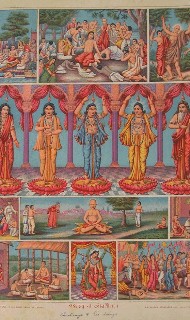
Using Prabhupada Memories
Websites from the ISKCON Universe
 Giriraj Swami and Guru Prasada Swami share more realizations of their lives in Krishna consciousness over the last decades.
Giriraj Swami and Guru Prasada Swami share more realizations of their lives in Krishna consciousness over the last decades.
“If we cry for Krishna, then we feel the effect of the holy name. Then the bond becomes so strong that when we are not chanting or not connected to Krishna for a moment it is like an infinity. Then we come to the final stage when we are really connected to Krishna and the holy name. Then it doesn’t matter what is happening in our life — whether I’m happy, whether things go right or wrong. Whatever happens, Krishna is my unconditional Lord. My purpose in life is to serve Him, please Him, and do His will.”
— Guru Prasada Swami
Experiences and Realizations, Part 2: 50 Years of ISKCON, Dallas
My dad recently gave me a whole bunch of my old diaries. One of them is from the first Shelter tour, with Quicksand and Inside Out in the Summer of 1990. As I read it, it becomes clear that I never “surrendered” to ISKCON, at least not in a spiritual sense. It was very clear to me from the start that ISKCON was a mess. But I found one person in ISKCON who stood out from the turbulence like a port in the storm, and I surrendered to him, in the spiritual sense, becoming his student and taking him as my teacher, my guru.
Ironically, I met him while on stage with Zack de la Rocha screaming “No Spiritual Surrender.”
OK, I guess I did surrender to ISKCON too, but it wasn’t spiritual surrender, it was career surrender. I surrendered my career options in normal world in hopes of making a career for myself in ISKCON’s world. I did this while knowing fairly well how unstable and strange ISKCON was, so I definitely admit that I am the main person to blame for what I now rank this as one of my life’s top 10 bad decisions.
It took about 6 to 10 years for me to fully give up on my ISKCON-carrer-surrender idea. There were two major experiences that made this happen.
The first was when I developed the opinion in 1993 that a significant majority of people in charge of ISKCON were downright phobic of real Krishna consciousness, unless it was forced into the most starched, pressed, shaved, and bleached/dyed robes; Xeroxed and stamped bona-fide by GBC resolution. I realized they would never really embrace and support a personality like mine, which expresses itself without conformity to uniforms and bureaus. They would always keep me in the curtained corners of the rooms reserved for “dissidents,” “sahajīya” and “gopī-bhāva club members.”
The second experience that destroyed my resolve to build a career in ISKCON was when I saw, up close and first-hand, how eagerly and how thoroughly they wanted to scapegoat and sacrifice my guru’s career (he was the Headmaster of ISKCON’s boarding school in Vṛndāvana), at the exact moment that large sums of ISKCON money were placed at risk as a result lawsuits from the abused alumni of all ISKCON’s boarding schools. Hmmm, a “moral” issue indeed. The complexities of his case are significant and are not the topic of this article. The way this experience damaged my carrer-surrender is the topic. I thought, “He’s willing to die for ISKCON, and they still want to kill him? Forget about it, it’ll never be safe for me here. If I make a mistake, or am even in charge of other people who make mistakes – they will roast me to protect themselves.”
Anyway, the ultimate point here is that I’m not shy of surrender as a result of being burned by surrendering to ISKCON. (A) I’m not shy of surrender, I’m shy of the word. More on that in a moment. (B) I never surrendered to ISKCON, anyway. (C) I was never burned by the person I did surrender to, my guru. (D) ISKCON did “burn” me in some significant ways, but I feel that’s my own stupidity, or was just simply unavoidable in the quest for the rare thing that I wanted and still want to somehow achieve.
The ramifications of making a drastically bad career decision at the age of 20 certainly still affect my life and some of my feelings about ISKCON, but have nothing much to do with my relationship to guru or Krishna, or with my concept of “spiritual surrender.”
My issues with spiritual surrender are their own. They lie in the semantics of the connotations. For example, ISKCON linguistics tends to say something like this, “The disciple surrenders fully and officially to the guru at dīkṣā.” Because of connotations, I’m not comfortable with this choice of words. I would express the same point using these words, “Dīkṣā occurs when a student fully accepts a teacher, and the teacher fully accepts a student.”
First of all I get rid of the word “official.” Who needs that? I have to file papers with some “office” even to get self-realization!? A great sādhu once told my guru, “In spiritual life, nothing is a formality.”
Second, I get rid of the word “surrender.” Why? Because I already say that I, “fully accept you as my teacher. ” If I accept you as my teacher, the connotation is that you have knowledge and experience that I do not and you are capable of transmitting that knowledge and experience to me. Thus the connotation is full of humility and surrender. What is the need for explicitly using the word “surrender” – which brings in new connotations, strange connotations, as if there was a war going on between us which I now give up on, or that I am going to give you something without getting anything in return?
The English word “surrender” is mostly a word with negative connotations. Why should we try to use it in a positive way, against the way our subconscious naturally hears it? Simply because our previous gurus chose this word? Are we eternally preschool neophytes beholden to our previous gurus’ choice of English words, when English was not their native language? Are all of us forever unfit to serve their mission by translating their message into terminology that better communicates to native and modern minds?
“Surrender” gives the wrong impressions, because it has confusing and inappropriate connotations.
“Surrender to guru” for example, is a very confusing phrase.
First of all, it implies passivity. When we surrender we are done. But nowhere does śāstra describe the disciple’s role as passive! On the contrary, the disciple is enjoined to be inquisitive (jijñāsu, ŚB 11.3.21) and question from every angle (paripraṣna, BG 4.34)! Certainly, the disciple feels grateful to and humble in comparison to the teacher (sevā and praṇipāta for example, from BG 4.34), but is never passive as the word surrender implies.
Better to say, “Humbly knowing the guru to have knowledge and wisdom you do not, inquire carefully from all angles, and tend to whatever needs the guru may have.” That would, in my opinion, very accurately reflect Krishna’s advice in Gītā 4.34.
Wikipedia suggests the following definition of “surrender” in a religious sense: “To surrender in spirituality and religion means that a believer completely gives up his own will and subjects his thoughts, ideas, and deeds to the will and teachings of a higher power.”
What the hell is that?
Whatever it is, it is not ŚB 11.3.21 or BG 4.34! It is not gauḍīya-vaiṣṇavism, which never gives up individuality and individual will, but applies individuality and freewill to the service of the Supreme Individual.
Clearly, then, “Surrender to guru” is a slogan that creates a mood of passivity, which generates mindlessness, which degenerates gauḍīya-vaiṣṇavism into a cult. The proof is in the pudding! Many, many members of ISKCON descended into a significantly mindless and culty society, especially when this “surrender to guru” talk was at its max-perihilion during the late ’70s and ’80s, though many ISKCON members may not be fully aware of this history because disclosure of it is very thoroughly avoided in ISKCON.
Where in śāstra is the Sanskrit word that is the basis for what we describe as “surrender”?
Is it शरणागति (śaraṇāgati)? How could “surrender” be the best translation of this term when शरण (śaraṇa) means “help, protection, refuge.” A clearer translation of this term would certainly be “Seeking Refuge.”
Maṁ ekaṁ śaraṇaṁ vraja (BG 18.66) “Surrender unto me alone” doesn’t imply that we should fight with everyone else, and fight against everything else, except Krishna – with him we should be passive puppets. No! It means, “I am the only one you need seek for refuge and protection!”
Then, is समर्पण (samarpaṇa) the Sanskrit word for “surrender”? No, not when arpaṇa means “giving.” A clearer translation is certainly something like “giving everything.”
Is it निवेदण (nivedana)? I’m sorry, that’s not it either. Almost everyone knows that वेद (veda) means “knowledge.” Ni-veda means “disclosing knowledge,” as in communicating, confiding, or revealing oneself.
All of the above certainly have some connotations in common with some of the connotations of “surrender” – which surely explains why several important 19th and 20th century figures trying to export knowledge of bhakti-yoga from Sanskrit and Bengali into English and other languages may have chosen to use the word. But “surrender” has so many connotations that are not in congruence with the primary meanings of words like śaraṇāgati, samarpaṇa, and nivedana. For example, it has military connotation and fails to communicate the warmth and emotional intimacy in these Sanskrit words.
If “Surrender to Guru” is confusing, what then is the proper attitude towards guru and Krishna?
It is “surrender.” That’s not “wrong,” it’s just not the best word. A better description of the correct attitude towards guru and Krishna is one where we feel the powerful need for their help and protection and guidance, so we give all our efforts towards availing ourselves of what they give by trying our best to comprehend and put their guidance into practice.
This is why, in all my recent writing about guru-tattva I haven’t used the word “surrender” much, if at all.
Vraja Kishor das
www.vrajakishor.com
Gita verse-by-verse study Podcast
Download by “right-click and save content”
The post Gita 08.11 – Liberation in yoga requires renunciation appeared first on The Spiritual Scientist.
Podcast
Download by “right-click and save content”
The post Bhagavatam study 27 – 1.6.32-38 – Krishnas glories fulfill our search for pleasure appeared first on The Spiritual Scientist.

Sydney Opera House Harinam (Album with photos)
Caitanya Mahaprabhu has recommended that everyone chant the Hare Krishna mantra just to cleanse the dust from the heart. If the dust of the heart is cleansed away then one can actually understand the importance of the holy name.
Find them here: https://goo.gl/slTTbH

By Baladev das
2015 Prabhupad Book distribution marathon at ISKCON chowpatty began with H.H.Radhanath swami giving an inaugural talk on Sunday Nov 22nd. In his class, Radhanath swami spoke on how books are heritage of our entire Gaudiya sampradaya and Srila Prabhupad understanding the heart of his spiritual master brought out a revolution through his book distribution program. Maharaj also told that this was 500th year of Lord Chaitanya visiting Vrindavan and 50th year of Srila Prabhupad leaving Vrindavan. Prabhupad left Vrindavan to give Vrindavan to all of us. Finally Maharaj requested all to come together n cooperatively make this book distribution effort a big success. H.H. Radhanath swami’s talk on inaugurating book marathon is available below.
https://www.youtube.com/watch?v=nxIWFKZqZfc




Protection (Album with photos)
Indradyumna Swami: One of the beautiful features of India is that there are ancient temples of the Lord everywhere throughout the country. Nearby where we are staying in the south is an old temple where Lord Nrsimhadeva is worshipped. The other day we visited the temple to have the Lord’s darshan and pray to Him. One time Srila Prabhupada said that he introduced the worship of Lord Nrsimhadeva in ISKCON specifically for the protection of the movement and the spiritual master.
Find them here: https://goo.gl/y8HeEb
The post On chanting 1, at kirtana night at Inis Rath appeared first on SivaramaSwami.com.
Gluttony or Gluttony without bhakti, over the past few week’s I have been pondering this.
December is meant to be the time of year of peace and goodwill to all mankind as those from the Christian faith remember the appearance day of Jesus Christ, although the date is highly questionable if you take into account the story of Jesus birth.
However I sat on a number of occasions in the supermarket watching the many steeped shopping trolleys, given the shop was only closed for one day I wondered if their was an apocalyptic catastrophe. Most of those I know no longer believe in Jesus his birth but still describe themselves as Christian.
Sat there I was reminded that one of the seven deadly sins described in the bible is gluttony, but when celebrating the appearance of Jesus Christ that’s what happens an over indulgence of wine, food and expensive gifts.
Their was also for me an irony in it all, say people were celebrating my birthday, special meal was put on and gifts given out but I wasn’t invited how would I personally feel?
Angry? Upset? Confused?
And get the crowds of people were doing that, gearing up to celebrate an amazing appearance of Jesus who directed the masses to practice Christian Bhakti to become God Conscious, Krishna Conscious; it reminded me of stories of bygone Christmas Celebrations, a day spent in fellowship with other believers, hearing stories of Jesus Christ’s pastimes and a humble meal as a community.
Boxing day was an interesting observation, it was then small gifts were given, these were practical gifts one of my favourite stories was of a young girl who recalled her gift was a pane of glass for the window; maybe not the most dazzling of presents but she said how much she loved the gift as the draft was less.
Then it reminded me of the iconic last supper, and how this was directed by Jesus Christ himself and was a very humble affair, no great opulence; and get again the whole motion of simplicity and association is missed.
Our gluttony should be that of wanting to stuff ourselves of the pastimes of a great saintly person as he talked about his farther and how to return back to his fathers heavenly abode. But looking beep at the TV schedule their was very little their that indicated this amazing event just a gluttony of soap’s, films and entertainment shows.
Further saddened was that speaking to some primary school parents the traditional nativity play has given way to some strange theatrical performance with no mention of Jesus so as not to offend, a celebration were the person whom it appertains to is neglected; but you would still describe oneself as Christian.
Commercialization.
The whole festival has become a gluttony of commercialism, profits before celebrating Jesus Christ as Acharia of the Christian faith.
What did I personally take from pondering and watching this sad dumbing down of Jesus Christ appearance day; that it is important that I remember with due diligence and with respect both the appearance day of the founder Acharia of ISKCON Srila Prabhupada.
But also that we don’t allow or encourage the commercialization of Diwali and other sacred celebrations, that we remain true to spiritual enlightenment and the pursuit of Krishna Consciousness that the temple and association of devotees.
This was we or should I say me personally don’t become sidetracked by material pleasures and sparkling nonsense gifts that keep me away from the path of self realization
HARE KRISHNA

Cape Town - December 2015 (Album with photos)
Snana Yatra, Ratha Yatra, Beach Harinama, Initiation Ceremony
Srila Prabhupada: The Hare Krishna mantra is specifically mentioned in many Upanisads, such as the Kali-santarana Upanishad, where it is said: “After searching through al the Vedic literature, one cannot find a method of religion more sublime for this age than the chanting of Hare Krishna.” (Sri-Caitanya-caritamrta, Adi-lila, 3.40 Purport)
Find them here: https://goo.gl/ydZESE
Answer Podcast:
Download by “right-click and save”
The post Why do jnanis need many lives to become jnanavan? appeared first on The Spiritual Scientist.
Answer Podcast:
Download by “right-click and save”
The post Why are the eka-bhakti jnanis of Gita 7.17 considered jnana-mishra? appeared first on The Spiritual Scientist.

“The Eye to See the I” free on kindle for five days!
The Eye to See the I features 121 reflections on the Bhagavad-gita that make its insights appreciable in brief, relishable nuggets of wisdom. The book published in hard copy on Janmashtami last year is already nearing the end of its first print run and will go for the second print soon. Recently released on kindle, it is now available free for five days from 6th Jan to 10th Jan.
Some of the reflections in the book are:
Money talks – and walks away as it is talking
We can’t replace the mind, but we can re-place it
The soul seems far out because it is far in
Free love is a self-contradiction
The heart of knowledge is the knowledge of the heart
Let repetition be a re-petition
The past won’t last if to Krishna we hold fast
With punchy titles that distill each article’s central message, the Eye to See the I addresses a wide variety of issues, all meant to help us realize and relish the innermost core of our being.
The hard copy of the book can be ordered from voicebooks@voicepune.com, and the details to download the kindle version are found here: http://goo.gl/RtTuEO







By Subhang Balaram Das
25th December 2015, marked the first day of the 14th ‘Bhagavat-Katha Saptah’ in Pune with HH Lokanath Swami Maharaja. Every year devotees from all over the world set aside the last seven days of the year and join Maharaja for ‘nityam bhagavata-sevaya’. Surely there is no better way than this to not only end a year, but also begin a new one. This katha proved to be a very special one as there was glorification of one dhama each day.
It was a feast for devotees accompanying Lokanath Swami Maharaja who was wearing the spectacles of scriptures. The journey commenced in Badrikasarama and proceeded through Rameshwaram, Dwarka, Mayapur, Jagannath Puri and finally to Vrindavan.
Day One was set aside for the glorification of the person Bhagavat – His Divine Grace A.C. Bhaktivedanta Swami Prabhupada. Flowing through the teachings and pastimes of Srila Prabhupada Maharaja stated – “I think the next time whenever Srila Vyasdeva adds new chapters to Srimad Bhagvatam, there will be mention of Srila Prabhupada”. Remembering the one who has given us Srimad Bhagavatam as well as taught us the practice of Bhagavat Dharma, was really a perfect start to the ‘Bhagavatam Saptah’ .
There are four significant Dhamas for the four ages (Satya-yuga, Treta-yuga, Dwapar-yuga and Kali-yuga). Our journey to Badrikashram, the Dhama of Satya-yuga started on the second day. Lokanath Swami Maharaja revealed that “whatever action a great man performs, common men follow”. Hence, the Lord incarnated as ‘Nara-Narayan’ to establish the principle of austerity. Thus one gets the lessons of both sense and mind control from the holy place.
On day three we were in Rameshwaram, the Dhama of Treta-yuga. This is where Lord Sri Rama within just five days, built the 800 mile long bridge with the help of ‘Hanuman &Construction Company’. Lokanath Swami Maharaja quoted, “Scripture is the science. One who knows the scriptures is the scientist. Thus, Bhaktivedanta Swami was a scientist. Bhaktisiddhanta Saraswati was a scientist.”
Dwarka was our third Dhama. The fourth day brought immense joy in passing through the pastimes of Supreme Personality of Godhead – Sri Krishna. Dwarka Dhama was where the Lord spent the maximum duration of his lifespan. The katha was a real visual experience of those amazing pastimes – how He killed the demons, married 16108 wives. Maharaja said: “It was not a big deal for the Lord to be in 16108 forms. There were 3 crore Gopis in the ‘Rasa lila’. Even then it is no big deal for Him as He lives within every heart. Thus, there is one Krishna for everyone. There is a need to understand that being His fractional potency one should serve Him. It is only in this manner that one can make ones life successful.
The fifth Day was dedicated to Mayapur Dhama, the birth place of Lord Caitanya. Lord Caitanya, who is Krishna Himself,appeared in the mood of Radharani. It was truly inspirational to go through the latest incarnation of the Lord, His pastimes, how He raised the glories of Jagannatha Puri and how He took sannayasa just for the well-being of all people.
The katha proceeded to the Dhama of Kali-yuga – ‘Jagannath Puri’ on the sixth day. Maharaja explained in detail the science behind the transcendental Deity form of Jagannatha, Baladeva & Subhadra. One can easily forget oneself listening to the glories of darsana and prasada of Lord Jagannatha. Lokanath Swami Maharaja quoted: “Jagannatha means Lord of Universe, hence Srila Prabhupada has taken Him to the whole world through chariot festivals”. It was a extremely impressive experience to hear about the first Chariot festival. This was at the Golden gate in San Francisco with 10 thousand devotees in attendance. It was therefore no surprise that this place which was then named ‘New Jagannatha Puri’ by His Divine Grace.
On the last day of the Katha, we finally reached Vrindavan Dhama – the source of all Dhamas. Diving through the glories of Vrindavan Dhama, Lokanath Swami Maharaja mindfully focused on the 500th anniversary of Lord Caitanya’s arrival in Vrndavana. There were vivid descriptions of how the wild animals were dancing with Lord Caitanya when He was passing through the forests of Jharkhand. “When the wild animals were dancing, hugging and kissing each other forgetting all their lust, greed, anger, arrogance, attachment and jealousy, Lord Caitanya exclaimed – This is only the Vrndavana. Thus by establishing ‘Brotherhood’ one can convert his temple, ashram and home into Vrndavana, that is the goal of International society of Krishna consciousness.”
This Bhagavad Katha took us on a journey through the wonderful holy Dhamas, Lokanath Swami Maharaja continuously reminded us of a few important essentials. The Dhama is eternal. One should not consider any Dhama to be a part of any state or country. One should be careful to avoid all of the Dhama offences. Finally, Maharaja said that it is a misunderstanding to think that the pastimes occurr only in particular age, because often the pastimes keep going on in the Dhama. It is one’s birth right to be there as a constant associate of the Lord so that is what one should always strive for.
A very big thank you to Lokanath Swami Maharaja for such an inspiring and delightful journey.




Beginning with Lord Caitanya Mahaprabhu himself, the leaders of Krsna Consciousness have always tried to share with and convince the leaders of states to accept this sublime science. By this as, Krsna mentions in Bhagvad Gita the common people are inspired to follow, and accept spirituality.
Following in the same lines devotees at ISKCON Patna, received on the very first day of the year, the Health Minister of the state of Bihar Mr. Tej Pratap Yadav at the temple here.
They gifted him the ‘Bhagvad Gita-As It Is’, which he gladly accepted. He was also given gifts like paintings and picture frames of Lord Krishna.
On this occasion the ISKCON Youth Forum(IYF) director of the state , Rambhadra Das, Temple Vice- President, Jagadish Shyam Das and other senior devotees of temple were present. The minister said that ISKCON is doing valuable service to humanity by distributing knowledge amongst masses through Gita, which is the crown jewel of India’s spiritual heritage . He said he would love to visit the temple again in future.
Padasevan Bhakta Das
Executive Head
Media and Promotions Deptt.
Iskcon Youth Forum, Delhi

KK Bindu #366, “The Devotees are Your Life”, a prayer to Jagannath by the Muslim born Salabega, plus more … The latest issue of Sri Krishna-kathamrita Bindu e-magazine was just released. This issue includes: * QUALIFICATION TO PRAY – Instructions from His Divine Grace A.C. Bhaktivedanta Swami Prabhupada. * MOOD OF THE VAISHNAVAS – Sri Srimad Gour Govinda Swami Maharaja explains why a vaishnava never demands respect. * THE DEVOTEES ARE YOUR LIFE – A first time translation done especially for this issue of Bindu. In Odisha this song by the Muslim born Salabega is one of the most famous and beloved prayers to Jagannath. * JEWELS FOR BUTTERMILK – A fresh translation of a pastime of Sri Chaitanya Mahaprabhu done for this issue from Srila Lochan Das Thakur’s, Sri Caitanya-mangala. It can be downloaded here: https://archive.org/details/bindu366

Ecstatic Book Distribution Outreach Programs By Iskcon Vrindavan (Album with photos)
ISKCON Vrindavan Namahatta Department organised the most ecstatic book distribution programmes outside of Vrindavan. Book distributors covered Mathura, Agra, Bharatpur, Aligarh, Raya, Jaipur, Palwal and many towns in Rajastan, dispite the cold weather. Under the expert guidance of His Grace Radhashyam Sundar Prabhu, devotees have distributed thousands of Bhagavad Gita’s and Krishna Books. The marathon is still continuing for another 10 days, after which the total book scores will be published.
Find them here: https://goo.gl/yHhgX9
 By Mahatma das
By Mahatma das How to Change this Year? You Need to Freak Out! Our cultural conditioning tells us we should make resolutions for the new year. Of course, the perennial problem is that most of us haven't followed through on our previous year's resolutions. And it can even get depressing to think about how many times this has happened. So maybe it is better we don't make any resolutions this year. This way we'll have nothing to lament about in early February when we haven't followed through. Well, actually I think it's a better idea to understand why we don't follow through on our resolutions, since I doubt that we will ever lose the tendency to want to change things about ourselves and our lives that aren't working well for us. So the important question is, "How do we permanently change our actions?" Continue reading "New Year’s Resolutions
→ Dandavats"

By Titiksu dasa
The ISKCON 50/50 Campaign is an initiative to celebrate the 50th Anniversary of ISKCON throughout 2016.
Everyone is invited to join us and distribute 50 BBT books in 2016. That’s an average of just one a week.
Here’s how to get involved:
1. Locate an ISKCON Temple or Centre near you. Go to: www.iskcon5050.com/contact for the international address list.
2. Contact the Temple and ask to take part. Ask for a score sheet.
3. Discuss options for distribution. There are many: Meeting people in the street. Book tables. Visiting shops and businesses. Sponsoring books for giving to friends, relatives and work colleagues, and for distribution to prisons, hospitals and hotels.
4. When you have distributed 50 books and filled up the score sheet, return it to the Temple. If you would like to do more, ask for another sheet and more books.
5. The Temple will give you a certificate of appreciation signed by the Chairman of the Governing Body of ISKCON and your local Temple President.
Book distribution is a very powerful way of giving the Holy Name to others. This is also known as sankirtan. Lord Sri Chaitanya Mahaprabhu has described sankirtan in His famous siksastikam prayers:
“Glory to the Sri Krishna sankirtan, which cleanses the heart of all the dust accumulated for years and extinguishes the fire of conditional life, of repeated birth and death. This sankirtan movement is the prime benediction for humanity at large because it spreads the rays of the benediction moon. It is the life of all transcendental knowledge. It increases the ocean of transcendental bliss, and it enables us to fully taste the nectar for which we are always anxious”.
ISKCON’s Governing Body (GBC) invites everyone to take part:
“For the pleasure of Srila Prabhupada the GBC is most delighted to fully endorse the 50/50 Campaign. The GBC would like to invite all devotees to participate in this wonderful initiative in celebration of ISKCON’s 50th year”
The post Daily Darshan : January 4th, 2016 appeared first on Mayapur.com.

January 4. ISKCON 50 – S.Prabhupada Daily Meditations.
By Satsvarupa dasa Goswami.
Prabhupada did not write as a mechanical routine; it was real for him, and so it can be real for us if we tune in to his wave length. Prabhupada refers to this as “submissive aural reception.”
When we can read in this way, it becomes enjoyable. When we read only as duty, we become guilt-ridden. We think, “I know I am supposed to worship this book, so why can’t I? What is wrong with me?” Then we start forcing ourselves and kicking ourselves, “Read Prabhupada! You are supposed to do it!” But if you push and nag a little child, he will not like it and he will rebel. While reading and walking with the Isopanisad, I found myself spontaneously appreciating Prabhupada’s purport, “Hey, this is good!” (I also got renewed appreciation for the fact that the verses were translated by Prabhupada. They had his flavor, “The self-sufficient philosopher who is awarding everyone’s desires since time immemorial …”)
Read the entire article here: http://www.dandavats.com/?p=20490&page=4
Life Beyond Borders – Kirtan | Veda London
The Eye to See the I features 121 reflections on the Bhagavad-gita that make its insights appreciable in brief, relishable nuggets of wisdom. The book published in hard copy on Janmashtami last year is already nearing the end of its first print run and will go for the second print soon. Recently released on kindle, it is now available free for five days from 6th Jan to 10th Jan.
Some of the reflections in the book are:
With punchy titles that distill each article’s central message, the Eye to See the I addresses a wide variety of issues, all meant to help us realize and relish the innermost core of our being.
The hard copy of the book can be ordered from voicebooks@voicepune.com and the kindle version can be downloaded from
The post The Eye to See the I free on kindle for five days appeared first on The Spiritual Scientist.
Śrīmad Bhāgavata 11.3.21: “śābde pare ca niṣṇātaṁ, brahmaṇy upaśamāśrayam.”
Bhagavad Gītā 4.34: “upadekṣyanti te jñānaṁ, jñāninas tattva-darśinaḥ”
Bhagavad Gītā 4.34: “tad viddhi praṇipātena, paripraśnena sevayā”
Śrīmad Bhāgavatam 11.3.21: “tasmād guruṁ prapadyeta, jijñāsuḥ śreya uttamam”
Gita verse-by-verse study Podcast
Download by “right-click and save content”
The post Gita 08.10 – Yoga restrains the negative, bhakti energizes the positive appeared first on The Spiritual Scientist.
Podcast
Download by “right-click and save content”
The post Bhagavatam study 26 – 1.6.23-31 – Devotion offers the supreme liberation appeared first on The Spiritual Scientist.
We usually find dīkṣā translated as “initiation” because to “initiate” something is to start it, to set it in motion – and dīkṣā is the thing that starts us in a certain direction.
In bhakti-yoga, dīkṣā is the thing that starts our devotional practices, sādhana-bhakti. Dīkṣā is the beginning of yoga. By dīkṣa we are accepted into a “school” of yoga and begin to be given whatever techniques and materials the school employs in its educational process.
Dīkṣā must be followed by śikṣā, specific and personalized instructions on the school’s philosophy and objectives, and similarly personalized instructions on how to employ the techniques and materials (given through dīkṣā) to realize that philosophy and obtain those objectives.
Dīkṣa and śikṣā are compulsory. In any field, to be guided by an expert is essential, but in bhakti-yoga it is absolutely mandatory because the primary subject (pure love, uttama-bhakti) is so subtle and elusive, and so foreign to our current nature.
There is a single practice which comes before this dīkṣā and śikṣā, it is called śrī-gurupādāśraya – to seek (a) competent guru(s). Of course, some education (śikṣā) is required at this stage as well. Thus śikṣā precedes and proceeds from dīkṣā. The śikṣā prior to dīkṣā however, is less personalized and more focused on basics like learning to identify a guru, and determine the most optimum school for one’s current level of “study.”
There are essential and non-essential components of dīkṣā.
The most essential component of dīkṣā occurs in the heart. The disciple decides to accept someone as his or her guru, guide, sacred teacher – and that person decides to accept the disciple as his or her śiṣya, pupil, sacred student.
The next most essential component of dīkṣā is that the guru transfers specific techniques and materials to the disciple – that he or she will use as the basis of their spiritual discipline and practice. Usually this is gradual, the guru giving the disciple new techniques when he or she is competent and ready for them. In gauḍīya-bhakti-yoga, the most essential among the materials is Śrīmad-Bhāgavatam and the most essential among the techniques is kṛṣṇa-nāma-saṁkīrtana and specific mantra, especially the two Krishna-mantra beginning “kṛṣṇāya govindāya…” and “kāmadevāya vidmahe…”
These two components are the essence of dīkṣā. Without them, “dīkṣā” is not dīkṣā. Other components often accompany dīkṣā – to make it more emotional impactful and significant for the disciple, and to help the disciple in other ways. Here are some of those components:
Disciple and Guru express their commitment to one another vocally and/or symbolically, before witnesses – often including sādhus, sacred fire, and the sacred mūrti.
Guru gives (a) mark(s) to the disciple that visually identify him or her as a member of the school. These often include the following: a specific tilok mark on the forehead, a specific name, tulasī necklace (and also for kṛṣṇa-nāma-saṁkīrtan), and a specific tattoo or brand.
All of these components are helpful but none are absolutely essential to dīkṣā.
Vraja Kishor dās
The post Ireland appeared first on SivaramaSwami.com.
Podcast
Download by “right-click and save content”
The post Positive Thinking 33 – Tap the power of meditation appeared first on The Spiritual Scientist.
 ———————————————————————————-
———————————————————————————-
Giriraj Swami and Guru Prasada Swami look back at their service in ISKCON over the last 50 years.
“I remember when a devotee came up to me and said, ‘Ten years ago I met you on the street and you gave me a book. From that book I found a temple and became a devotee.’ That is such a rewarding experience. Sometimes when you distribute books or do any service, you feel a little overburdened because there is so much to do for Krishna. But when you get that reciprocation from the deities or someone you have preached to, it makes everything worthwhile. You think, ‘I can participate in this way in Krishna consciousness.’ That is how I have put my little grain of sand into this movement — by trying to pioneer. And I am still trying to do that to some degree — if Krishna gives me the chance.”
—Guru Prasada Swami
Over the last year the Auckland temple devotees organised about 10 Rathayatras in the area. The big cart was used for the city and a smaller cart for the suburbs and nearby towns.
A few days ago a Rathayatra went around the farm itself and the devotees danced and chanted ecstatically in front of Their Lordships, Jagannatha, Baladeva and Subhadra Devi.

First Harinama of 2016 in Kiev, Ukraine (Album with photos)
Khreshchatyk is the main street of Kiev, Ukraine. The street has a length of 1.2 km. It stretches from the European Square through the Maidan and to Bessarabska Square where the Besarabsky Market is located.
Find them here: https://goo.gl/isKNpY
A memorial service will be held 11:00 am, Monday, January 5th, at the ISKCON New Vrindaban Temple. Friends are welcome at the service and the reception at the family home from 2:30 to 5 p.m.

A memorial service will be held 11:00 am, Monday, January 5th, at the ISKCON New Vrindaban Temple. Friends are welcome at the service and the reception at the family home from 2:30 to 5 p.m.
 By Krishna Dharma dasa
By Krishna Dharma dasa It was good to see a scholar tackling the uncertain area of morality in Vaishnavism, as did Ms Chatterjee with her essay, 'The Chaitanya School: Role of Ethics'. I found her essay thought provoking and a valuable contribution to what I feel is an area requiring much discussion. Although, as Ms Chatterjee rightly pointed out, Vaishnavism holds that 'spiritual progress is hardly possible without moral endeavour', the first requirement being of course the 'four regulative principles', it is still somewhat hazy, especially amongst ISKCON followers, exactly what our code of ethics should be. Do we follow varnashrama dharma or not? Are Vaishnavas transcendental to all external designations and thus the duties pertaining to them? How much is a Vaishnava serving Krishna to be bound by codes of worldy morality? Of course, one would expect a Vaishnava to display the highest moral character, and indeed Ms Chatterjee's first point was that one who surrenders completely to the Lord will thereby attain similar qualities as those possessed by the Lord. In other words, by virtue of their surrender to God, Vaishnavas should naturally evince all godly qualities. She cites some of the many scriptural verses supporting this point, describing how a genuine sadhu or saintly person will evince superlative standards of morality. Continue reading "A Response to The Chaitanya School: Role of Ethics
→ Dandavats"

By ISKCON Communications Ministry
“Joy of Devotion” Inspires a Half-Century of Growth
Washington, D.C.—1966 was a significant year. Chairman Mao Tse-Tung’s “Little Red Book” was published for the first time. Despite mass protests, the United States began to bomb Hanoi, North Vietnam’s capital. The Soviet Union’s Luna 9 made the first soft landing on the Moon. Actor Ronald Reagan was elected governor of California. Indira Gandhi visited Washington. Walt Disney died. The Beatles performed their very last concert in San Francisco’s Candlestick Park.
And, on New York City’s lower east side, surrounded by a handful of young followers in a small storefront temple on 2nd Avenue, His Divine Grace A. C. Bhaktivedanta Swami Prabhupada incorporated a fledgling religious society. He named it the International Society for Krishna Consciousness, or ISKCON. On that hot summer day, the 13th of July, the Hare Krishna movement was born.
Few noticed the event. Fewer still would have expected this 70-year old swami and his band of reformed hippies to be more than a blip in the avant-garde history of New York City. But, fifty years later the society Prabhupada created is arguably the largest and most influential of global Vedic (Hindu) organizations, and the 600 plus Hare Krishna temples around the world attract an estimated nine million worshippers per year.
“Besides scholars, few people know the depth of the Krishna movement’s roots in India’s historic Vaishnava tradition, nor ISKCON’s impact as a leading proponent of devotional bhakti yoga around the world,” says Dr. Ravi Gupta, head of Utah State University’s Religious Study Department.
Srila Prabhupada passed away in November 1977. But, the movement he began has proven to be a resilient one. ISKCON today claims not just 600 temples, but 65 eco-farms and 110 vegetarian restaurants. Its affiliated Bhaktivedanta Book Trust is the world’s largest publisher of Vaishnava literature and has distributed 516 million books and magazines.
In addition, ISKCON’s affiliated Annamrita Food Relief program feeds 1.2 million school children every day in India, and ISKCON is the official faith partner with the British government for the Krishna Advanti schools, which oversees multiple schools. ISKCON’s world headquarters in Mayapura, West Bengal India, draws one million pilgrims each year and a new Temple of Vedic Planetarium is under construction that will hold 10,000 people in the main worship hall.
As early as 1975, scholars took note of ISKCON’s growth. Dr. A. L Basham, author of the famed book, “The Glory That Was India,” wrote that “The Hare Krishna movement… is historically very significant, for now, for the first time since the days of the Roman Empire, an Asian religion is being openly practiced by people of western origin in the streets of western cities.”
“ISKCON teaches that every living being is an eternal soul, and that happiness comes from awakening our relationship with God, Sri Krishna, the all-attractive person,” said Anuttama Dasa, ISKCON’s Communication Minister. “People know that a consumer driven life is a dead end; when they experience the joy of bhakti, or devotion, they realize this is what they are looking for.”
ISKCON inaugurates a year of celebrations marking the 50th Anniversary on New Year’s Eve. Throughout the year events will include major Rathayatra (“Giant Chariot”) parades down New York’s 5th Avenue, Washington’s Independence Avenue, Toronto’s Yonge Street, and London’s Trafalgar Square; as well as celebratory festivals and events to coincide with the July 13 anniversary date.
In addition, gala VIP dinners are planned for Sydney, London, New Delhi, Mumbai, and Washington. And, a 64-year old Krishna monk will walk for six months across the entire United States, commemorating Prabhupada’s teachings and ISKCON’s growth across America and the world.
 By Chanda Chatterjee
By Chanda Chatterjee Any discussion on religion remains incomplete without a reference to moral and ethical values. The case of Gaudiya Vaishnavism is no exception to that. It is true that ethics has not been systematically treated by the Gaudiya philosophers and that the issue in question has not been discussed independently, yet the fact remains that morality or ethics remains the sheet-anchor in their thought system. The philosophers of this school maintain that spiritual progress is hardly possible without moral endeavour; hence, they consider religion and ethics as inseparable As a matter of fact, the merging of the two remains an important feature for them. However, in the absence of any methodical exposition, we have to draw largely upon the teachings of Sri Chaitanya and the examples set by him and his close disciples. Continue reading "The Chaitanya School: Role of Ethics
→ Dandavats"